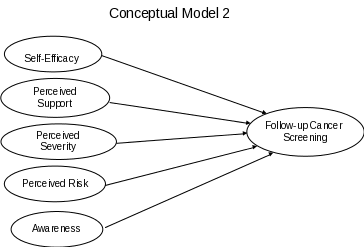Attachment C - Technical Supplement
Attachment C_Technical supplement.doc
A Study of Primary and Secondary Prevention Behaviors Practiced Among Five-Year Survivors of Colorectal Cancer
Attachment C - Technical Supplement
OMB: 0920-0815
Attachment C
Technical Supplement: Study Questions and Domains
Figure C-1. Hypothesized Relationships among Variables Related to Perceived Benefits and Barriers, and Actual Prevention Behavior
Figure C-2. Two Conceptual Models of Prevention Behavior
Concepts, Variables, and Instruments Used in the Survey of Health Behaviors

Figure C-2. Two Conceptual Models of Prevention Behavior


Concepts, Variables, and Instruments Used in Survey
Perceived Severity (Question # 68-72)
In order to measure participants’ perceptions of the severity of cancer recurrence, participants will be asked how severe the health consequences of getting cancer again would be for them and how much it would disrupt their physical comfort, emotional well-being, physical appearance, and life as a whole. Response options will be on a six point scale where 1 indicates not at all disruptive and 6 indicates very disruptive. These questions were adapted from a scale used by Aiken and colleagues (1994) in a study of mammography screening to assess the perceived severity of a potential breast cancer diagnosis. Cronbach’s alpha for the scale used by Aiken was .91.
Perceived Susceptibility (Question # 63-66, 100-101)
Participants will be asked to rate their chances of getting cancer of the colon or rectum again in the future and getting another type of cancer in the future, from very low to very high. They will also be asked to rate their chances of getting cancer again compared to other people. These questions have been adapted from the Health Information National Trends Survey (HINTS) administered by the National Cancer Institute.
Perceived Benefits and Barriers (Question # 24, 31, 38, 79, 87, 102)
Perceived benefits of routine check-ups, colonoscopy, CEA testing, prostate cancer screening, exercise, nutrition, and weight management will be assessed. Participants will be asked if they strongly agree, agree, are uncertain, disagree, or strongly disagree that the target behaviors make them feel good/are reassuring, are important for their health, make them look good, increase their chances of living a long life, or reduce their chances of getting cancer. These questions were developed specifically for this study and are based on barriers and benefits referenced in the health promotion/health behavior literature.
Perceived barriers to routine check-ups, colonoscopy, CEA testing, prostate cancer screening, exercise, nutrition, and weight management will be assessed. Participants will be asked if they strongly agree, agree, are uncertain, disagree, or strongly disagree that the target behaviors are inconvenient or difficult to arrange, cost too much money, are harmful, take too much time, make them worry they’ll find out something is wrong, are painful or embarrassing, are difficult or tiring, or are unpleasant or uncomfortable.
Self-Efficacy (Question # 27, 33, 40, 45, 51, 81, 89, 104)
Participants will be asked if they are not at all confident, slightly confident, moderately confident, mostly confident, or totally confident that they can go in for routine check-ups, colonoscopy, prostate cancer screening, exercise on a regular basis, eat a healthy diet, achieve or maintain a healthy weight, avoid smoking, and limit or avoid drinking alcohol when recommended. These questions were developed specifically for this study.
Cues to Action (Question # 53, 75, 82, 90, 92, 94, 97)
Participants will be asked if they have ever received advice from a doctor, nurse, or other health professional about 1) where they should go for routine check-ups after completing treatment for cancer, 2) when they should return for a colonoscopy, and 3) getting screened for prostate cancer by having a PSA test or DRE exam. They will also be asked if they have ever received advice from a doctor, nurse, or other health professional about 1) getting regular exercise, 2) having healthier eating habits, 3) limiting or avoiding alcohol, 4) taking vitamins or supplements, 5) taking aspirin, 6) not smoking cigarettes, 7) having a healthy bodyweight, 8) learning more about their cancer, 9) reducing stress in their life, 9) getting the support they need from others, and 10) caring for their mental or emotional health.
Perceived Support (Question # 26, 32, 39, 44, 50, 59, 80, 88, 103)
Participants will be asked if they strongly agree, moderately agree, neither agree nor disagree, moderately disagree, or strongly disagree with the following statement “Close friends and family members think it’s important that I… (go in for routine check-ups, undergo regular screening by colonoscopy, be screened for prostate cancer, get regular exercise, eat a healthy diet, achieve or maintain a healthy weight, avoid smoking, and limit or avoid drinking alcohol).”
Participants will also be asked if they have friends or family members that they can talk to about their health and how often they talk to them about their health.
Worry about Cancer Recurrence (Question # 67)
Participants will be asked whether they worry about getting cancer again rarely or never, sometimes, often, or all the time.
Satisfaction with Medical Care (Question # 58)
A modified version of the short form of the Patient Satisfaction Questionnaire (PSQ 18) is being used. The PSQ-18 contains 18 items that measure seven domains of satisfaction with medical care: general satisfaction, technical quality, interpersonal manner, communication, financial aspects, time spent with doctor, and accessibility and convenience. This instrument was modified to make the questions specific to the cancer care patients have received. Psychometric testing of the PSQ-18 showed acceptable internal consistency and reliability, especially in view of the abbreviated length (Marshall and Hays, 1994).
History of Cancer and Cancer Treatments (Question # 54-56, 60-62)
Questions will assess how participants were originally diagnosed with CRC (i.e., whether through screening or symptoms), whether they have been diagnosed with any other cancers, and whether they received various treatments (e.g., surgery, chemotherapy) for their CRC.
Comorbidities (Question # 8)
Comorbidities will be assessed through a 1-item question asking participants to indicate whether they have experienced any of a number of heath conditions in the past year.
Health-Related Quality of Life (Question #1-7)
The SF-12 version 2 will be used to measure health related quality of life. The SF-12v2 is a subset of the SF-36. The 12 items in the SF-12 provide a comprehensive representation of the 8 health concepts measured in the SF-36. The SF-12 is composed of two summary measures, physical health (PCS) and mental health (MCS). Each summary score is composed of four scales, (PCS= physical functioning, role-physical, bodily pain, and general health and MCS= vitality, social functioning, role-emotional, and mental health). Psychometric testing of the SF-12 showed acceptable internal consistency and reliability, especially when used with samples of 500 or more (Ware, Kosinski, & Keller, 1996).
Sociodemographic Characteristics (Question # 73, 105-112)
Sociodemographic factors are assessed by 1- and 2-item measures of race/ethnicity, age, sex, marital status, years of education, employment status, and insurance coverage. These questions are adapted from large, federally-funded public surveys such as the National Health Interview Survey (NHIS), and the Behavioral Risk Factor Surveillance System (BRFSS) survey.
Primary Prevention Behaviors (See below)
Primary prevention behaviors to be measured as outcome variables include physical exercise, healthy eating habits, weight management, smoking behavior, and alcohol consumption.
Physical Exercise (Question #10-23)
A modified version of the Godin leisure time exercise questionnaire (GLTEQ) (Godin et al., 1986; Godin and Shepard, 1985) is being used to assess physical activity. The GLTEQ consists of three questions that assess the average frequency of mild, moderate and vigorous exercise during free time in a typical week. We will also assess the average duration within each exercise intensity level. An independent evaluation of this measure found its reliability and validity to compare favorably to nine other self-report measures of exercise based on various indices (Jacobs et al., 1993).
Healthy Eating Habits (Question # 29-30)
To assess eating habits, participants will be asked whether they eat certain foods never, rarely, sometimes, often, usually/always, or don’t know/not sure. Foods of interest include fruits and vegetables, saturated or trans fats, whole grains, processed meats, fish, poultry or beans, and low-fat and fat-free foods. Questions for this assessment are directly based upon nutritional guidelines issued by the American Cancer Society, and the U.S. Department of Health and Human Services.
Weight Management (Question # 34-37)
Questions asked to assess weight management include current height and weight to calculate BMI and whether they have tried to gain or lose weight since their colorectal cancer diagnosis.
Smoking Behavior (Question # 41-43)
Smoking behavior will be assessed by asking participants if they smoked at the time of their colorectal cancer diagnosis (every day, some days, not at all), if they are currently smoke (every day, some days, not at all) and if they have ever tried to quit smoking since their CRC diagnosis.
Alcohol Consumption (Question # 46-49)
Participants will be asked how many days in the last month they consumed at least 1 alcoholic beverage, an average of how many drinks they had on the days when the drank in the last month, and if they drink more or less since their colorectal diagnosis.
Medical Follow-up and Screening Behaviors (Question # 74, 76-78, 83-86, 93, 95, 98-99)
To assess medical follow-up, participants will asked how many colonoscopies they have had since completing treatment, how much time has elapsed since their last colonoscopy, when they are due for another colonoscopy, and if they ever missed or skipped a colonoscopy. For CEA testing, participants will be asked how much time has elapsed since their last CEA test and if they have ever missed or skipped a CEA test. Participants will also be asked about their routine medical care. Questions include what kind of doctor they see for routine care (primary doctor, oncologist, gastroenterologist, other), how much time has elapsed since their last routine visit, when they are due for another routine visit, and whether they ever missed or skipped a routine care visit.
Participants will also be asked questions about their use of cancer screening tests by mammogram, Pap testing, PSA (Prostate Specific Antigen) testing and DRE (Digital Rectal Exam). For mammography and Pap testing, women will be asked how much time has elapsed since their last mammogram and Pap test. For PSA and DRE, men will be asked how much time has elapsed since their last PSA or DRE and if they ever missed or skipped a PSA test or DRE. Questions to assess whether participants are up-to-date with the various screening recommendations are adapted from CDC’s Behavioral Risk Factor Surveillance System (BRFSS) survey.
Page
| File Type | application/msword |
| File Title | Attachment H: Technical Appendix |
| Author | arp5 |
| Last Modified By | arp5 |
| File Modified | 2009-03-20 |
| File Created | 2009-03-20 |
© 2025 OMB.report | Privacy Policy